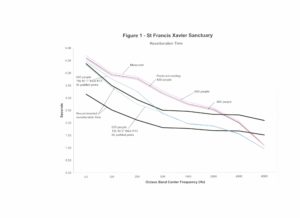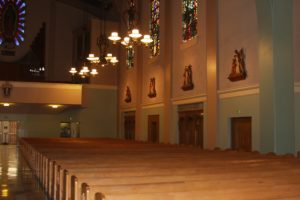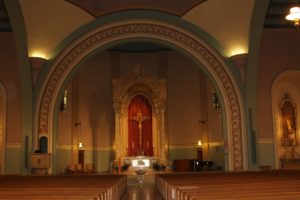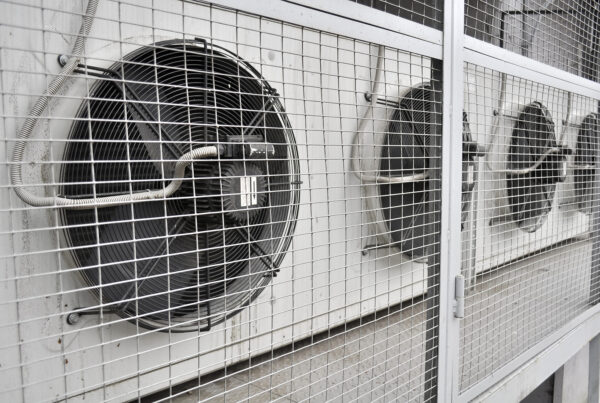Acoustic Measurements
Using acoustical measurement techniques is imperative for large room acoustics. Sound energy is injected into the room using an active monitor and the signal is then measured for different variables. One of the most important variables with churches is reverberation times. We have the spoken word and the musical word. Even though both have their own individual acoustical needs to sound well, there must be a balance struck between the two when we are talking about reverberation time.
Speech And Music Reverberation Times
For speech, we like reverberation times around one second. Remember, our T60 times means the amount of time it takes our signal to decay from its current reverberate signature down to 60 dB in the room. This defines the speech intelligibility range we need to achieve. Music, on the other hand, likes longer reverberation times. Musical energy requires reflections, voice energy does not.
Church Measurements
We recently measured a church in our community for reverberation times because they were having a problem with hearing both music and vocals. Things had gotten so bad that they moved the choir from the rear of church loft down to center stage. Here is the report the testing team generated.
Background
Reverberation time is a tool used to evaluate the acoustics of spaces. Reverberation time is a measure of how long sound stays present within a space after it is made. More specifically, reverberation time is defined as the time required for the level of sound in a room to drop 60 dB after the signal is turned off.
Preferred Reverberation Time
The preferred reverberation time for a space is dependent upon its physical volume, as well as its intended use. For instance, for speech, we normally want a relatively short reverberation time within a space. If the reverberation time is too long and if the speaker does not speak slowly, a listener will actually hear sound from more than one word simultaneously.
Garbled Sound
The result is a garbled sound that is not easily understood. On the other hand, if music is played within a space with a long reverberation time, the musical notes tend to blend together which is more pleasing than a dry dead sound. So the use of a space has a lot of bearing on what reverberation time is most desirable.
Music And Speech
It is our understanding that a balance between speech intelligibility and musical quality is desired. For the sanctuary, a reasonable reverberation time design goal should be between 2.0 and 2.5 second for mid-frequency sound (500 to 1,000 Hz) to provide reasonable speech intelligibility and musical quality. The reverberation time within a space can be controlled by the ratio of sound-absorptive surface area to sound-reflective surface area.The recommended reverberation times are shown in Figure 1.
Sanctuary Results and Recommendations
The reverberation time was measured in the sanctuary and the average measured reverberation time is shown in Figures 1. A loudspeaker was used as a noise source and a microphone and real time analyzer were used to measure the reverberation time. The measured reverberation time was used to verify the reverberation time model.
Reverberation Times Too High
As you can see in Figure 1 the existing reverberation time in the sanctuary above the recommended range. We recommend applying acoustical treatment in the sanctuary to reduce the reverberation time. There are many types of acoustical treatments including: wall panels, stretch fabrics, baffles, lapidaries, open wood system, perforated metal systems.
Cellulose Spray On
We recommend spray-on acoustical treatment which is available as a relatively soft cellulose fiber-material or as a cement-based plaster. Sprayed acoustic material is applied by many local insulation contracting companies. The sprayed material should be applied directly to the ceiling and walls to provide the recommended surface area.
National Cellulose Corporation
One product is K-13 from National Cellulose Corporation. The cost is $2/ft2 for 1″ thick treatment and $3/ft2 for 2″ thick treatment. It comes in six standard colors and costs $5,000 for each non-standard color. The cost of a lift is additional as is the cost if a significant covering up that is needed. Figure 1 shows the impact of adding 27,000 ft2 of 1″ thick and 2″ thick spray-on acoustical treatment.
Ray Trace Analysis
A ray trace analysis was performed and the direct and first reflection paths are shown in Figures2, 3 and 4. Reflections are beneficial when the distance of direct path and the reflected path are less than 55 feet. Reflections cause an echo, which reduces speech intelligibility, when the distance of direct path and the reflected path are more than 65 feet.
All Surfaces Contributing
As can be seen, the back walls, ceiling and most side walls do not provide beneficial sound reinforcement. This makes it more difficult to hear a person talking without a sound system. A reflective ceiling cloud could be installed above the chancel to provide some constructive natural sound reinforcement. Reflective cloud can be constructed or purchased from Kinetics and Wenger.
Loudspeaker System
It is very important that the sound system is directed on the audience with as little spillover as possible. We generally recommend that a central loudspeaker cluster be located up high and directed down onto the audience. All side walls that are at or above the height of the loudspeakers will not provide beneficial reflections – the higher the loudspeakers, the more beneficial wall area.
Human Hearing Localization
In addition, because our ears are horizontally aligned, we distinguish noise sources side to side more than up and down. Hence, a loudspeaker above or below the speaker sounds like it is coming from the speaker which is not the case for loudspeakers located horizontally away from the speaker. An alternative to a central cluster, for very large reverberant churches, is a distributed system. This system would have loudspeakers along the walls throughout the sanctuary.
Human Hearing Disadvantage
The disadvantage is that it is apparent that the noise is coming from the side loudspeakers and not the front of the sanctuary. If acoustical absorption can not be added, this is a reasonable alternative. The ceiling does not need to be treated if all of the side walls are treated and the loudspeakers have minimal acoustical energy going towards the ceiling. We recommend applying acoustical treatment on the following surfaces, in order of importance:
Room Surface Treatment Priorities
1. The rear wall – it causes long delayed reflections and the perception that the sound source is behind you. ( ~ 3,000 ft2)
2. The rear walls of the side wings. (~ 2,700 ft2)
3. The side walls of the side wings. Treating the rear half is most important. (~ 6,250 ft2)
4. The side walls of the main sanctuary. Treating the rear half is most important. (~ 7,200 ft2)
5. Absorptive seating will provide a more even reverberation time that is not as dependent on the number of people in attendance. With 600 people in attendance, absorptive seating will provide ~ 6,000 ft2 of absorption.








